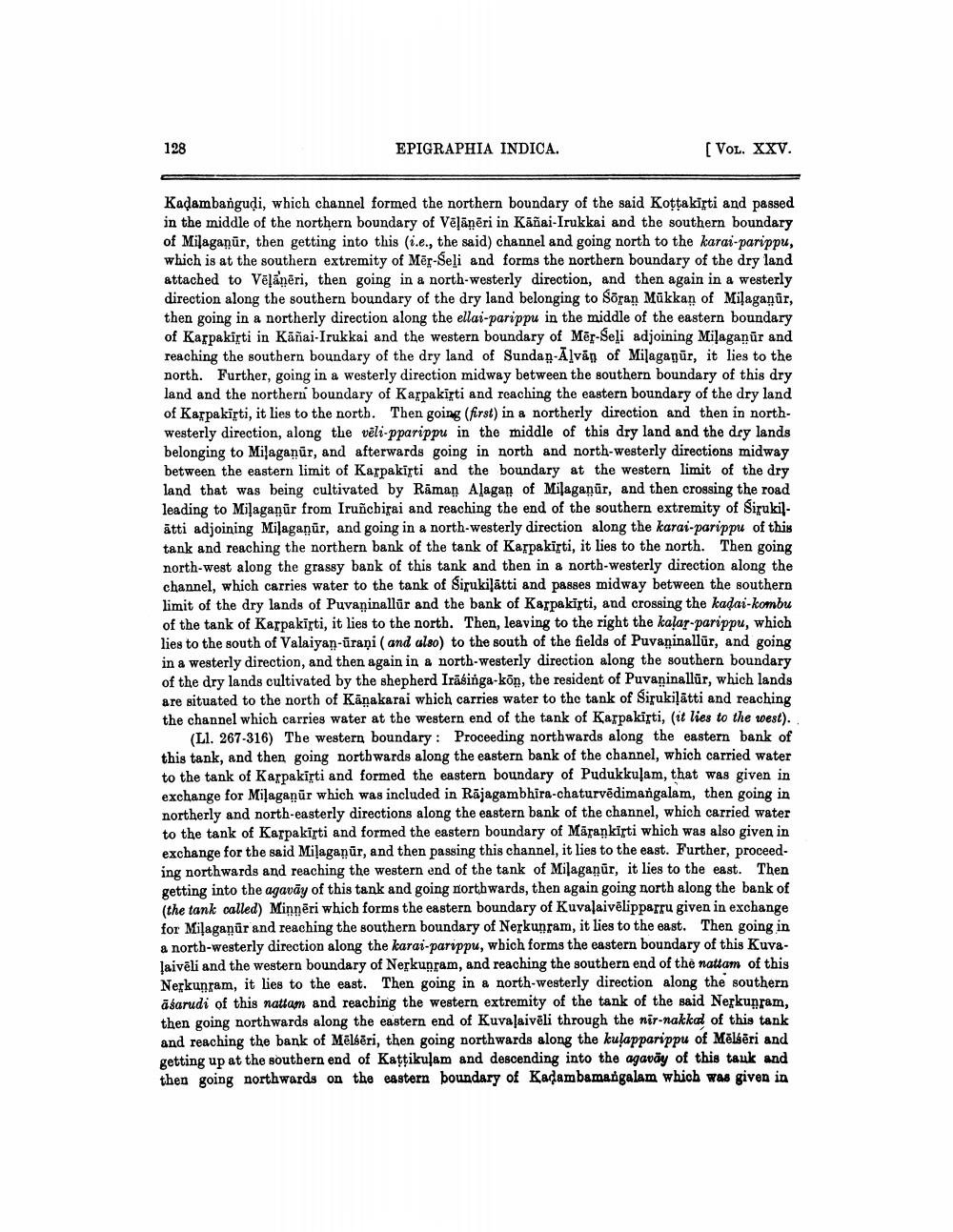________________
128
EPIGRAPHIA INDICA.
[VOL. XXV.
Kadambanguļi, which channel formed the northern boundary of the said Kottakipti and passed in the middle of the northern boundary of Vēļānēri in Kanai-Irukkai and the southern boundary of Milaganür, then getting into this (i.e., the said) channel and going north to the karai-parippu, which is at the southern extremity of Mēr-Seli and forms the northern boundary of the dry land attached to Veláneri, then going in a north-westerly direction, and then again in a westerly direction along the southern boundary of the dry land belonging to Sõran Mükkan of Milaganür, then going in a northerly direction along the ellai-parippu in the middle of the eastern boundary of Karpakirti in Käñai-Irukkai and the western boundary of Mēr-Seli adjoining Milaganūr and reaching the southern boundary of the dry land of Sundan-Alvāŋ of Milagaŋür, it lies to the north. Further, going in a westerly direction midway between the southern boundary of this dry land and the northern boundary of Karpakirti and reaching the eastern boundary of the dry land of Kappakirti, it lies to the north. Then going (first) in a northerly direction and then in northwesterly direction, along the vēli-pparippu in the middle of this dry land and the dry lands belonging to Milaganūr, and afterwards going in north and north-westerly directions midway between the eastern limit of Karpakisti and the boundary at the western limit of the dry land that was being cultivated by Raman Alagan of Milaganūr, and then crossing the road leading to Milaganūr from Iruñchirai and reaching the end of the southern extremity of Sirukilätti adjoining Milaganür, and going in a north-westerly direction along the karai-parippu of this tank and reaching the northern bank of the tank of Karpakirti, it lies to the north. Then going north-west along the grassy bank of this tank and then in a north-westerly direction along the channel, which carries water to the tank of Sirukilātti and passes midway between the southern limit of the dry lands of Puvaninallür and the bank of Karpakirti, and crossing the kadai-kombu of the tank of Karpakirti, it lies to the north. Then, leaving to the right the kaļar-parippu, which lies to the south of Valaiyan-ürani (and also) to the south of the fields of Puvaninallür, and going in a westerly direction, and then again in a north-westerly direction along the southern boundary of the dry lands cultivated by the shepherd Irāśinga-kon, the resident of Puvaninallür, which lands are situated to the north of Kāņakarai which carries water to the tank of Sirukiļātti and reaching the channel which carries water at the western end of the tank of Karpakirti, (it lies to the west).
(Ll. 267-316) The western boundary : Proceeding northwards along the eastern bank of this tank, and then going northwards along the eastern bank of the channel, which carried water to the tank of Karpakirti and formed the eastern boundary of Pudukkuļam, that was given in exchange for Milagaņūr which was included in Rājagambhira-chaturvēdimangalam, then going in northerly and north-easterly directions along the eastern bank of the channel, which carried water to the tank of Karpakirti and formed the eastern boundary of Mārankirti which was also given in exchange for the said Milaganūr, and then passing this channel, it lies to the east. Further, proceeding northwards and reaching the western end of the tank of Milaganūr, it lies to the east. Then getting into the agavāy of this tank and going northwards, then again going north along the bank of (the tank called) Minnēri which forms the eastern boundary of Kuvalaivēlipparru given in exchange for Milaganūr and reaching the southern boundary of Nerkunram, it lies to the east. Then going in a north-westerly direction along the karai-parippu, which forms the eastern boundary of this Kuvalaivēli and the western boundary of Nepkuoram, and reaching the southern end of the nattam of this Nerkunram, it lies to the east. Then going in a north-westerly direction along the southern āsarudi of this nattam and reaching the western extremity of the tank of the said Nerkunram, then going northwards along the eastern end of Kuvalaivēli through the nir-nakkal of this tank and reaching the bank of Melbēri, then going northwards along the kulapparippu of Mēlbëri and getting up at the southern end of Kațţikulam and descending into the agaväy of this tauk and then going northwards on the eastern boundary of Kadambamangalam which was given in




